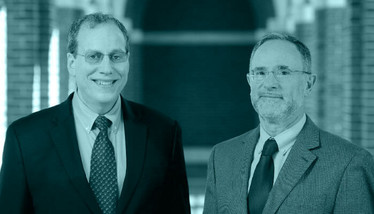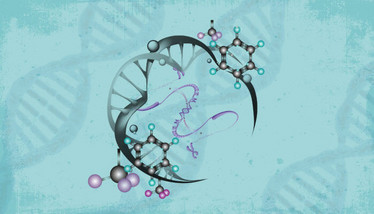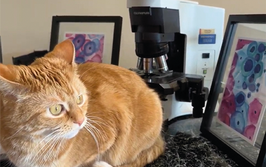
Lessons Learned, with Andrew Feinberg
From Cornell to Westminster Abbey, Feinberg has traveled a compelling career path. Here, he describes his journey and offers his thoughts on the future of epigenetics
At a Glance
- Working alongside great mentors and collaborators enables different perspectives to combine, helping solve complex problems
- Epigenetics is a relatively young but rapidly evolving field that must be incorporated into the broader medical research picture
- The National Institutes of Health are one of the great triumphs of western civilization, but more funding should go to “high-risk, high-reward” projects
- Because of the strong relationship between early life exposure and what happens to that person later in life, it is important to take an integrated view of the life cycle
I started out as a kid interested in mathematics and computers. I took a year of college math at Cornell the summer after my junior year of high school, then worked at IBM Research after my senior year. I really thought that was what I’d end up doing. I never saw myself wanting to do biology and absolutely never thought about medicine, but, during my sophomore year at Yale, I picked up a catalog out of curiosity and noticed a five-year program at Johns Hopkins that led to a medical degree after only two years of university. I applied on a whim and, while working in France that summer (for IBM again), I received a telegram from my father saying that I had been accepted at Hopkins and he had sent in a deposit. There weren’t any discussions about it, and he said I could change my mind. But I thought it sounded good, and his judgment was probably better than mine at 19 – so that’s how I became a teenaged medical student.
Throughout my career, I’ve always had an instinct for finding really good teachers and collaborators, and I think that has been one of the most important advantages I’ve had. I had the good fortune of meeting eventual National Institutes of Health (NIH) director Bernadine Healy when she was a resident and I was a second-year medical student. She used to see me in the pathology lab, trying to learn to recognize tissues and diseases late at night, and she offered to tutor me through it. I just about managed to pass the course, which involved memorizing slides and subtle differences in tissues – a tough task for someone who can barely recognize peoples’ faces!
Another great colleague of mine was Sam Barondes, and it was with him in the late 1970s, as a postdoc, that I first thought about epigenetics. Together we worked on Dictyostelium, the slime mold; we were trying to solve the problem of differentiation to understand the fate of its cells. There are two types of slime mold cells: vegetative and sporulating. I figured out a way to achieve density separation of pre-spore and pre-stalk cells and label them differentially before reconstituting them into a vegetative state, or “slug.” When the cells differentiated again, we were amazed to see that they remembered their former identity. It was clear to us that they had some kind of “memory” of their future, which is an epigenetic trait, and this idea of epigenetic plasticity stayed with me throughout my research career. That’s the idea that eventually led me to conduct research into cancer epigenetics.
After medical school and some clinical training, I did a second postdoc in the early 1980s with Bert Vogelstein. We specifically tested the epigenetic hypothesis of cancer for the first time and discovered altered DNA methylation in human colorectal cancer compared with matched normal mucosa. As a Howard Hughes Investigator at the University of Michigan, I continued these studies. I found another great collaborator, Michael Debaun, a pediatric hematologist at Washington University at the time, and we set up a clinic for patients with Beckwith-Wiedemann syndrome (BWS), a congenital disorder that leads to Wilms tumor of the kidney. We showed that loss of imprinting of IGF2 specifically causes pre-malignant lesions in all BWS patients with this abnormality, and half of them develop cancer – a 500-fold increase in risk. Without this epigenetic change, though, patients are not at increased risk. It was the smoking gun that showed that epigenetic changes can cause cancer even in the absence of genetic mutations.

My epiphany
I got a lot of skepticism for my early work on epigenetics, especially by conventional “hardcore” transcription factor researchers. However, my persistence in epigenetics and a lot of evolutionary biology study on my own resulted in what I like to facetiously call my “epiphany,” because it happened in Westminster Abbey. Prior to that, I had been trying to understand how epigenetics could contribute to understanding the puzzle of missing heritability of disease – that is, that common variants do not explain most of the genetic risk. I couldn’t work out how epigenetic traits were transmitted through many generations, which was a common view at the time, but ran counter to my studies of the powerful reprogramming in the genome we see for imprinted genes.
I was in London with my son enjoying some of the sights when it occurred to me: maybe there’s a role for stochasticity in human disease. It sounds like a scene from a movie, but I was standing in front of Charles Darwin’s grave in November 2009 because a sign outside Westminster Abbey announced that it was the 150th anniversary of On the Origin of Species. Next to Darwin’s grave is Isaac Newton’s grave, and you are not allowed to stand on it. Just above Newton’s grave is a plaque in honor of Paul Dirac, one of the founders of quantum theory in physics, which introduced stochasticity above conventional Newtonian physics. There was no such plaque in front of Darwin’s grave, and the absence caused me to realize that stochasticity could be important if the environment often changes. My idea was that multicellular, phenotypically complex organisms that evolve in a sporadically changing environment might develop genetic variants that themselves cause epigenetically mediated phenotypic variability. This would provide a selective advantage – for example, if organisms have a growth advantage in an environment with abundant nutrients, but then those nutrients become scarce for many generations, and then continue to switch back and forth between the two extremes.

It occurred to me at the same time that this epigenetically mediated stochasticity could also underlie tumor cell heterogeneity, which is what had gotten me interested in cancer research years earlier in the first place. This idea would imply that there is a cellular mechanism for switching epigenetic stochasticity on and off, perhaps by the compartmentalization of large chromatin regions that contain varying degrees of intrinsic noise. This stochasticity could be helpful when cells need to change their phenotypic state, such as in the epithelial-mesenchymal transition in normal repair mechanisms after injury. However, they also might be aberrantly and constitutively reactivated in cancer, enabling the tumor to adapt epigenetically to a changing environment.
High risk, high reward
Epigenetics is a branch of genetics that I used to follow in its entirety, but now it has grown to the point where I just can’t keep up with all of it. I think it’s wonderful to live in a state of some degree of ignorance, because it forces me to keep asking questions. My response to that is to read widely and frequently, but also to be prepared for unexpected ideas to appear from nowhere, just waiting for me to grab them and start working through them – “How do I test it out? What do I do?” I find this process extremely exciting, but also a little scary – especially as grant reviewers generally want you to have a substantial amount of preliminary data before they will support your ideas. I understand why they take that approach and I agree with it; they have to make sure the money is well-spent and scientific rigor is upheld. However, I’m constantly grateful that the NIH also supports innovative research. The NIH is, in my view, one of the great triumphs of our government, and its contributions to humankind are incalculable. In its portfolio, I believe that “high-risk, high-reward” research is crucial; we should look for more ways to increase it, particularly in areas where individual institutes may not be able to fund some of the big trans-disciplinary ideas on their own and can collaborate with other institutes to identify potential breakthrough projects.
I also hope for epigenetics to be incorporated more formally into big human disease risk studies. Epigenetics stands right at the center of gene-environment interaction, and I believe it has a huge role to play in predicting and mitigating human disease. In the future, we might be able to make epigenetic predictions about everyday life; for instance, by determining what an individual’s diet should be to maximize health. Epigenetics is also important in viewing the life cycle in an integrated way. There is a strong relationship between prenatal and early life exposure and what happens to an individual later in life, and it may not be limited to a single generation. Most importantly, epigenetic diagnostics and therapy may be used to tailor environmental exposure, and to deliver precision medicine to both genetic and epigenetic targets to improve human health.
Andrew Feinberg is Bloomberg Distinguished Professor of Medicine, Biomedical Engineering, and Mental Health at the Johns Hopkins University School of Medicine, Baltimore, USA.




















